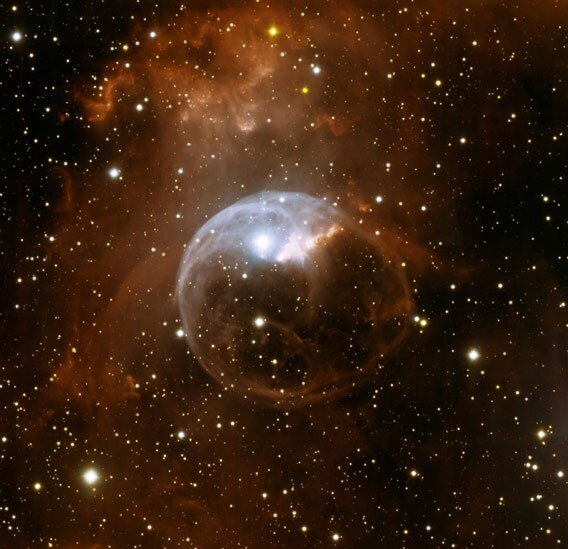Create a free profile to get unlimited access to exclusive videos, sweepstakes, and more!
Blowing a Cosmic Bubble

The Sun is hardly an average star; by mass itâs in the upper 80th percentile of all stars in the entire Universe. But much, much beefier stars exist, like SAO 20575 (or, if you like these alphabet soup catalog names, itâs also called BD+60 2522). It tips the cosmic scale with at least 15 times the Sunâs mass: Itâs a hot, luminous star, so energetic itâs blasting out a fierce wind of subatomic particles thatâs actually carving a gigantic bubble in the surrounding material.
That all sounds a bit clinical, until you see a picture of what this awesome power means:
This structure is called the Bubble Nebula, and it is literally a cavity, an evacuated region, left behind as the stellar wind from the star expands. Itâs huge, roughly 10 light years across. Thatâs 100 trillion kilometers (60 trillion miles), hundreds of thousands of times the size of our entire solar system.
The star sits near the edge of a molecular cloud, a dense clump of gas and dust that may be dozens of light years across. The star itself is near the top of the bubble. Itâs not centered because the surrounding material isnât evenly distributed; itâs denser near the top of the bubble, so the starâs wind has a harder time pushing against it. Itâs also possible the star is physically moving in that direction, contributing to it not being centered in the cavity.
But still, itâs pushing hard. Bear in mind our own Sunâs wind barely reaches 20 billion kilometers, and even then itâs stopped by the ethereal wisps of material between stars. The material in the molecular cloud can be thousands of times denser than the space near the Sun, so itâs very thick by galactic standards. But then, the wind from SAO 20575 is nearly a billion times stronger than our own Sunâs solar wind and moving dozens of times faster than a rifle bullet. Thatâs a lot of force.
All of this attests to what a monster that star is.
In fact itâs not clear just how massive it is. Violent stars make it difficult to measure their mass, but one study found it to be 45 times the Sunâs mass, which is flipping huge. We see powerhouse stars like this scattered around the galaxy, though not very many. Itâs hard to make stars a lot bigger than the Sun, and the more massive they are the more rare they are. Stars make energy by fusing elements in their core, similar to the way a nuclear bomb does. The more massive the star, the hotter the core, and the faster the reactions go, making more energy. A star more than about 150 or so times the mass of the Sun generates so much energy that it quite literally and enthusiastically tears itself apart.
Yeah, think on that for a moment.
While SAO 20575 isnât that massive, itâs still plenty luminous. It gives off so much energy that it floods the surrounding space with ultraviolet light strong enough to make the gas glow, similar to the process that lights up a neon sign. Itâs lighting up its own environment so fiercely we can see it from thousands of light years away. Itâs incredible.
This picture was taken with a new camera called the One Degree Imager, mounted on the WIYN 3.5-meter telescope. It sees a big chunk of sky; what I put here is only a piece of the much larger full image. And this camera is still being commissionedâonly 13 of its 64 light-sensitive digital detectors were used here!âand will be even more capable soon. Even better news is that I see my old friend and astronomer Travis Rector is behind this image, and he is a master of astronomical imaging. I cannot stress enough how beautiful his work is, and if heâs involved with this camera, then weâll be seeing even more remarkable images from it over time.


























